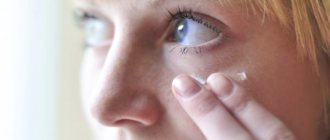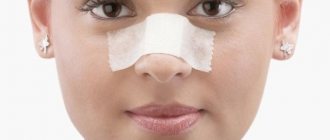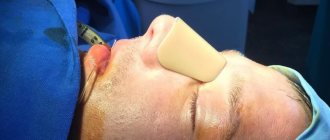Structure and functions of the nasal septum
The nasal septum consists of three parts: bone (it is located quite deep inside the nasal cavity and consists of bones), cartilaginous (in the form of a quadrangular cartilage) and mobile (the area from the skin between the nostrils to the cartilaginous part).
The nasal septum divides the nasal cavity into two nasal passages, thereby determining the uniformity of air flow during breathing. It also performs important supporting and formative functions - it is directly involved in giving a certain shape to the nose, especially its apex and lower surface.
Causes of development of a deviated nasal septum
Physiological – occurs as a result of disharmonious development of parts of the nose at a young age. Most often, non-traumatic curvature takes the form of a complete displacement towards the entire septum, thickening ridges, or outgrowths-spikes.
types of deviated nasal septum
Traumatic – occurs as a result of external, most often mechanical, impact. In most cases, the injury combines damage to the structures of the nasal septum itself and the bones of the nose, which causes a significant cosmetic defect and requires septoplasty of the nasal septum in combination with rhinoplasty.
Compensatory (adaptive) - occurs when in the nasal cavity there is some kind of formation outside the septum itself, exerting pressure on the latter. In this situation, surgery on the nasal septum is combined with surgery to eliminate the cause of the deviated nasal septum.
Tumors of the nasal septum - and this is not always cancer; in most cases, tumoral curvature of the nasal septum is caused by polyps, benign tumors.
What is the name of the operation to correct a deviated nasal septum and how does it proceed?
The operation to correct the nasal septum includes several stages. First of all, it is necessary to conduct an examination. The doctor prescribes a number of tests and procedures:
- Blood test: biochemical, coagulation, HIV, hepatitis, syphilis;
- Consultation and opinion of an ENT specialist, dentist, therapist;
- Fluorography;
- Electrocardiogram.
If, after studying the tests, the patient receives permission to undergo surgery, doctors begin preparing him. The patient is sent for an X-ray, with the help of which the doctor determines the nature and extent of the damage, the type and shape of the curvature. Based on all the data received, the doctor makes a decision on the method of performing the operation.
Preparation
Before surgery, you should stop taking medications that reduce blood clotting, such as aspirin, diclofenac and others.
Since the operation to correct the nasal septum is performed on an outpatient basis, and it lasts a maximum of 1.5 hours, no serious preparatory procedures are prescribed. The patient is advised to eat a light dinner the evening before surgery and not eat anything else until surgery. It is allowed to drink clean water in moderation. General or local anesthesia is performed. When local anesthesia is prescribed, the patient takes sedative medications an hour before the procedure.
Stages of implementation
How is a classic operation to correct the nasal septum performed:
- Injection of an anesthetic, for example Lidocaine, into the cavity.
- Anesthesia of the nasal area.
- Cutting tissue in one or two nasal passages.
- Detachment of the mucosa and perichondrium.
- Separation of cartilage tissue followed by removal.
- Using a chisel to remove ridges or spikes in the bone tissue, they are the ones that provoke curvature.
- The incision site is sutured, fixing tampons are inserted. They keep the septum centered and absorb excess blood.
Elimination of a deviated nasal septum lasts on average one hour; in case of complications, the time increases to one and a half hours.
Indications for surgical treatment
There are often cases when a person has a number of symptoms, sometimes severe, and does not even suspect that the cause of his troubles is a deviated nasal septum. The decision to use surgical treatment is made in the presence of severe symptoms:
- Cosmetic defect - this includes a crooked nose, a hump, a depression, or simply an irregular shape of the nose;
- Constant runny nose - frequent mucous discharge from the nose;
- Chronic nasal congestion on one or even both sides, which can be manifested by breathing through the mouth;
- Feeling of dryness in the nose and mouth;
- Noisy breathing during sleep;
- Snoring, often very strong;
- Frequent nosebleeds, sometimes for no apparent reason;
- Allergic reactions up to manifestations of bronchial asthma;
- Frequent colds;
- Frequent and chronic inflammatory diseases of the paranasal sinuses - maxillary, frontal and others;
- Headache;
- Increased fatigue, decreased attention and performance, memory impairment;
- Reduced sense of smell.
It should also be taken into account that in the presence of a pronounced curvature of the nasal septum and the absence of the above symptoms, it makes sense to perform surgical straightening of the nasal septum, since, especially at a young age, compensatory and adaptive mechanisms are able to neutralize the clinical manifestations. With age, the body's adaptive abilities, which previously coped with the task, are depleted, and symptoms begin to increase, and performing surgery at a more mature age is not always possible due to the general condition of the organs and systems.
When is the deferral due?
If a young man is diagnosed with a deviated nasal septum, he is unlikely to be accepted into a military school, where they train specialists for the Ministry of Internal Affairs, the Ministry of Emergency Situations, the FSB, and the Airborne Forces. A person with such a defect, when extinguishing a fire, will not be able to breathe normally, perform forced marches, or jump with a parachute. But they accept military service during the conscription campaign with such a deviation. Only those conscripts who, in addition to a deviated nasal septum, will be diagnosed with “1st degree respiratory failure” can count on a deferment.
Article 49 of the list of illnesses indicates pathologies in which conscription can be temporarily avoided. These include:
- polypous sinusitis;
- purulent sinusitis;
- complications after operations in the maxillary sinuses.
You can count on a deferment if exacerbations occur several times a year and are confirmed by examination results. For polypous sinusitis, these are data from computed tomography of the sinuses.
To confirm the presence of chronic sinusitis, the conscript must be provided with a rhinoscopy, an x-ray in 2 projections. The presence of the maxillary form of the disease is confirmed by puncture. Respiratory failure is confirmed by examination in a hospital and dispensary observation for a period of no more than six months ago. With constant exacerbations, it is possible to get exemption from conscription.
See also
What will an ultrasound of the nasal and paranasal sinuses show in adults and children, indications and cost
Read
It is believed that military service is not impeded by:
- scars and cysts;
- thickening of the mucous membrane in the maxillary cavity;
- deviated nasal septum;
- atrophy of the lining of the respiratory tract.
If the barofunction of the maxillary sinuses is impaired, their radiography is required, a test that is carried out in a special chamber to determine the tolerance of pressure surges. Based on these results, a medical examination is performed.
Preparing for surgery
If a decision is made to perform surgery for a deviated nasal septum, a number of routine medical tests are prescribed to assess the general condition of the body and the presence or absence of contraindications for anesthesia and surgical treatment:
- General blood analysis;
- General urine analysis;
- Blood chemistry;
- Blood testing for the presence of HIV infection, viral hepatitis and syphilis;
- Coagulogram – determines the state of the blood coagulation system;
- Blood sugar level;
- Electrocardiography;
- Fluorography.
Sometimes, if necessary, the doctor expands the list of laboratory tests and makes appropriate prescriptions.
Immediately before the operation you should:
- Shave your mustache if you have one;
- Avoid drugs that reduce blood clotting (for example, aspirin, cardiomagnyl, heparin, Plavix, warfarin, diclofenac, indomethacin and others);
- You should also refrain from drinking alcohol and limit smoking.
Contraindications
Correction of a deformed septum is not carried out in the following cases:
- Diseases and disorders of the blood coagulation system.
- Severe decompensated diseases of internal organs.
- Mental illnesses and deviations.
A relative contraindication is the patient's age. Thus, this displacement is not operated on until the age of 18, but in special cases it can be performed on a child starting from the age of seven.
After 55-60 years, people also try not to do septoplasty, but if there are serious indications and the patient’s health allows it, then the doctor may take a risk. Septoplasty is not performed during pregnancy either.
Contraindications for surgical treatment
Surgery for a deviated nasal septum does not have any specific contraindications, which means that if a person can undergo any significant surgery, then he can also undergo septoplasty. But there are still certain contraindications:
- Age: over 50 years old, and also under 16-18 years old. This is due to the fact that after 50 years, atrophy of the mucous membrane occurs and it “loses” somewhat, which leads to the restoration of normal air flow through the nasal passages and, as a consequence, the pointlessness of the operation. At the age of under 16-18 years, surgical interventions on the cartilage and bones of the nose are undesirable, since until this age the growth of both cartilage and bone elements often remains, which can lead to the futility of the treatment. However, in the presence of pronounced defects and symptoms, surgery can be performed both from the age of six and after 50 years;
- The presence of an acute or aggravated chronic inflammatory disease;
- Presence of menstruation and the first week after it;
- Mental illnesses;
- Coagulopathies are blood clotting diseases;
- Decompensation of chronic somatic diseases;
- Tuberculosis of the lungs and upper respiratory tract;
- Severe atrophy of the epithelium of the nasal septum.
Breathing problems after surgery
Septoplasty, like any other operation, is a complex operation, and various complications can develop after it is performed. Patients who decide to take such a step should know what negative consequences can be observed after surgery.
During the rehabilitation period after surgery on the nasal septum, breathing problems are a common complication. This natural process is usually hampered by cotton swabs in the nasal cavity, swelling of the mucous membrane, crusts formed and a postoperative bandage. With the help of an applied bandage, it is possible to tightly fix the cartilage and bones, which helps prevent their displacement. It causes discomfort to the patient only on the first day after surgery, and after some time the person simply does not feel it.
Swelling of the nasal mucosa persists for 5-7 days, after which it begins to decrease and completely disappears after 3 weeks. In order to quickly relieve swelling during the recovery period after septoplasty, it is recommended to follow the following rules:
- maintain bed rest;
- take medications whose action is aimed at strengthening the vascular walls;
- take antihistamines;
- apply a compression bandage with ice;
- carry out physiotherapeutic procedures;
- humidify the air in the living room;
- use nasal sprays.
After surgery on a deviated nasal septum, you may experience pain in the teeth and nose, as well as numbness in this area. The development of this pathological condition is due to the fact that nerve endings from the gums and jaw pass through the nasal cavity. During surgery, they may be stretched or damaged, and subsequently the person will experience discomfort for several months.
Often after surgery for a deviated nasal septum, a sore throat occurs and this occurs due to minor damage to the mucous membrane. After a few weeks, this unpleasant symptom disappears and no longer bothers the patient. Characteristic manifestations after septoplasty are increased drowsiness, slight dizziness and weakness. During the rehabilitation period, it is possible to develop an allergic reaction to medications, and in some cases this can occur during surgery. With such a complication, the patient is selected for a different treatment regimen or prescribed antihistamines.
Anesthesia
Depending on where the curved area is located, the operation is performed using local anesthesia or general anesthesia (anesthesia).
Local anesthesia when straightening the nasal septum is performed when the curvature of the septum does not affect the bone part, but is localized only in the movable or cartilaginous part of the nasal septum - in these areas, the mucous membrane is irrigated with an anesthetic, or tampons soaked in an anesthetic are applied and, after complete loss of all types of sensitivity, start the operation.
When the curvature involves bone structures, or septoplasty of the nasal septum is only a part, or a stage of an extensive operation, then the patient receives general anesthesia. Children are also operated on in a state of anesthesia.
Methods of surgical treatment
Classic nasal septum surgery has been used since 1882. Naturally, over such a long period of time, enormous clinical experience has been accumulated, a great many modifications of surgical treatment have been developed, and at the moment time-tested techniques are used, which, in combination with modern technological innovations, are almost guaranteed to give a positive effect and cause a minimum number of complications.
Submucosal resection of the nasal septum
Killian's operation: The entire operation is performed inside the nasal cavity, that is, no incisions are made on the side of the facial skin and, as a result, the possibility of postoperative scars forming on open areas of the face is excluded.
submucosal resection of the nasal septum according to Killian
The essence of this operation is that inside the nasal passages, often under endoscopic control (then the operation is called endoscopic septoplasty), incisions are made in the mucous membrane of the nasal septum and perichondrium on both sides alternately. From the level of the roof of the nose to its bottom. In this case, a small sharp scalpel with a rounded, non-pointed tip is used, since the sharp end of the scalpel can easily cut through the entire thickness of the cartilage, as well as the perichondrium and the mucous membrane of the opposite nasal passage. The mucous membrane and perichondrium are dissected down to the cartilage.
Next, an anesthetic is injected under the perichondrium, after which, very carefully, so as not to damage the mucous membrane itself, through the incisions made, the mucous membrane is peeled off along with the perichondrium and periosteum to the required level.
If there is a ridge or spine of the septum, the detachment is performed bypassing it from the side of the roof and the bottom of the nasal passage, so as not to damage the mucous membrane in the area of maximum elevation of the defect. Detachment is carried out beyond the deformed part of the septum. Next, the nasal septum is straightened mechanically: the spines and ridges are cut off, the curvatures are excised, and both cartilage and bone can be corrected.
After leveling, the nasal septum is immobilized using tampons, the previously exfoliated mucous membrane, perichondrium and periosteum are pressed against the cartilage and bones using the same tampons. Often after surgery, wearing a sling bandage is indicated.
Conservative modifications of submucosal resection of the nasal septum proposed by V. I. Voyachek:
septal regression
Redressing the septum: The incision is made in the same way as in the case of Killian's operation, but only from the side of one nasal passage. Next, the perichondrium and periosteum are separated only on the side of the incision, and on the same side, four dissections are made directly on the cartilage itself so that the curved part of the cartilage is not connected to anything other than the mucous membrane, perichondrium and periosteum of the adjacent nasal passage. Using the same principle as with the cartilaginous part, the bony base of the nasal septum is dissected in the area of its curvature. As a result of the manipulations performed, the nasal septum becomes mobile and, without third-party intervention, takes on a natural position. After that, tampons are inserted into the nasal passages in the same way as during Killian's operation.
Mobilization of the septum: The essence and methodology of this modification is absolutely identical to regression, but affects exclusively the cartilaginous part of the nasal septum, without touching its bone part.
Circular resection: If, during mobilization of the septum, the cartilaginous quadrangle does not acquire sufficient mobility to establish the nasal septum in its natural position, then the incisions made are expanded by excising thin strips of cartilage.
Partial resection is a combination of the above modifications of operations on the nasal septum proposed by V.I. Voyacek.
Resection-reimplantation is a modification of the above surgical interventions, which involves excision of a curved fragment of cartilage, giving the excised area the correct shape and returning it back between the layers of the mucous membrane of the nasal septum.
Laser septoplasty
The method is based on a phenomenon discovered in 1992, the essence of which is that under the influence of a laser beam with certain characteristics, cartilage retains its previously given shape. The course of this operation includes mechanical straightening of the cartilage, bringing the laser to the site of the former curvature and laser exposure to this area through the mucous membrane, after which the cartilage retains its correct shape.
Laser septoplasty has a number of undeniable advantages:
- There are no incisions - the laser is applied without damaging the mucous membrane.
- The operation is absolutely bloodless.
- There is absolutely no risk of infectious complications, as well as the formation of hematomas.
- Can be performed on an outpatient basis - there is no need for a hospital stay.
- No postoperative swelling.
- Very short period of postoperative rehabilitation.
The use of a laser to straighten the nasal septum has a number of limitations and cannot be used in all cases. Firstly, this is due to the fact that the laser acts only on cartilage; therefore, treatment of defects in the bony part of the nasal septum is excluded. And, secondly, the laser can only preserve the shape of the cartilage given in advance, but it is not able to remove a ridge or spike. The laser is also ineffective if the curvature of the cartilage of the nasal septum is associated with compensatory reasons, which are described above.
The choice of any of the described surgical treatment options is dictated primarily by the prevalence and severity of the curvature of the nasal septum, as well as the technical capabilities of the clinic you contacted.
Rehabilitation
In the case of laser septoplasty, rehabilitation is practically not required due to the low traumatic nature of the method.
When performing classical septoplasty, in most cases a hospital stay of up to seven days is required.
In the first few days, there are gauze swabs in the nose, which prevent nasal breathing. In many clinics, ancient gauze tampons are replaced with silicone tampons or a special gel, which perform the same functions as gauze tampons, but contain special channels inside that allow nasal breathing to be maintained even in the early postoperative period, which significantly improves the quality of life during rehabilitation.
As soon as the time comes—approximately the second or third day, depending on the type of operation performed—the tampons are removed and the nasal passages are examined to monitor their condition. During a hospital stay, crusts are removed with the participation of medical personnel very carefully so as not to damage the injured mucous membrane of the nasal cavity.
During the recovery period, anti-inflammatory and painkillers are often prescribed to alleviate the patient's condition. In order to prevent infectious complications, antibacterial drugs are prescribed; their use can be either systemic (tablets, injections) or local - irrigation of the nasal mucosa.
After discharge from the hospital, before starting work, you must visit an ENT doctor at the clinic to monitor the condition of the nasal cavity. In most cases, if the work does not involve intense physical activity, you can start working after 10-14 days.
In order to prevent complications in the postoperative period, it is necessary:
- Avoid drinking hot food and drinks;
- Refrain from visiting the bathhouse, solarium;
- Limit the amount of time you spend in the sun;
- Protect yourself from intense physical activity.
Is it painful to have rhinoplasty and how dangerous is it?
A beautiful chiseled nose is the dream of every woman. If she is dissatisfied with her face, then the leader of the bad mood is her nose. After all, eyes, lips, cheekbones can be corrected with the help of decorative cosmetics, but this organ always remains unchanged.
On rhinoplasty forums, women often discuss such correction, its necessity, the dangers of the procedure, and the consequences.
Once the decision to undergo rhinoplasty is made, women ask about the procedure itself, and the main question is: “Does rhinoplasty hurt?” Let's consider important issues regarding nose correction in more detail.
Is it possible to have a nose job?
The question of the advisability of the operation is ambiguous. There are medical indications for rhinoplasty, which are given by the doctor in case of impaired nasal breathing due to anatomical abnormalities or a deviated nasal septum resulting from injury. The other side is an aesthetically unattractive nose. But often, women with beautiful nose shapes strive to improve it in order to be like their ideal, for example, their favorite actress. Nose surgery to achieve a certain shape is possible, but all risks must be assessed, because it is impossible to remake the nose back to its original shape.
In what cases is rhinoplasty performed for aesthetic reasons:
- strongly protruding hump;
- wide bridge of the nose;
- thick or drooping tip;
- flattened wide nose (Asian type);
- dilated nostrils;
- back too long;
- organ asymmetry;
- protruding bone or cartilage after a fracture (improper healing).
Any surgical operation carries a certain risk to human health, and sometimes even to human life. Therefore, it is necessary to consult with specialists about the need for nose correction and undergo a comprehensive medical examination before surgery.
How to eliminate risks associated with surgery:
- Get advice from doctors about your health status. The therapist must give permission for the operation, since rhinoplasty has contraindications. The most common are malignant tumors, autoimmune diseases, diabetes, mental disorders, chronic diseases and a number of other ailments.
- Complete all necessary laboratory tests, which include urine and blood tests, nasal x-rays and other examinations.
- Choose a clinic and a specialist who will perform the operation. Discuss with your doctor all the details of the upcoming correction in order to get as close to the desired result as possible. Follow his advice.
Is it painful to have nose surgery?
Rhinoplasty is a painful procedure, so the patient receives anesthesia. Depending on the deformation of the nose and the complexity of the operation, the type of anesthesia is determined and the optimal drugs are selected.
There are three types of anesthesia:
- Local . Used in case of minor impact on the nasal organ. Painkillers are injected under the skin and applied externally. The patient is conscious, sees and hears everything, but does not feel pain. There may be discomfort caused by the doctor using instruments, such as pressure.
- Local + sedation . The organ is frozen using painkillers, and the patient is also given small doses of drugs intended for general anesthesia. In this case, the patient feels drowsy and peaceful, but is conscious.
- General . The patient does not feel or understand what is happening, since consciousness is turned off with the help of special drugs. This type of anesthesia is preferable for both the patient and the surgeon, but is more difficult to perform and is less tolerated by the body.
How painful it is to undergo rhinoplasty depends on the psychological characteristics of the person. Everyone's pain threshold is different. One is able to adequately and calmly perceive the operation, the other panics and faints as soon as he sees a syringe or metal instrument in the hands of a doctor. Fear can cause pain where there is none.
Painful sensations occur when removing or changing tampons on the day of surgery. After anesthesia, the patient may feel weak and unwell.
Is rhinoplasty dangerous?
Nasal correction surgery is classified as the least dangerous type of surgery, but complications occur on average in 10 - 12% of patients. This is facilitated by poor quality examination of the patient before surgery (health status) and failure to follow the surgeon’s recommendations before or after nose correction. In rare cases, complications may arise due to poor instrumentation used to perform the operation or low qualifications of the doctor.
Natural consequences of the operation: hematoma, swelling, redness of the skin, difficulty breathing, disappear within a week or two. More serious violations remain for a long time.
Among them are the following:
- Impaired nasal breathing as a result of prolonged swelling or scarring of soft tissues if there were ruptures during surgery.
- The growth of tissue in the places of stitching (keloid scars) nullifies all the efforts of the surgeon, as they disfigure the nose.
- Perforation of the nasal septum.
- Callus formation.
- Cartilage growth.
The most common complication is patient dissatisfaction with the result. A new nose may look inorganic on the face, unattractively emphasizing other parts of it that previously looked good. In addition, the skill of the surgeon may fail. It happens that the nose after surgery has defects: irregular shape, asymmetry, dips, and so on.
Complications
This type of surgical intervention has been worked out in quite detail and the development of complications is a rare occurrence. Postoperative complications may manifest as follows:
- Formation of a hematoma - a tense cavity filled with blood between the cartilaginous or bone parts of the septum and the nasal mucosa;
- Bleeding from the nose;
- Perforation of the nasal septum - the formation of a canal connecting the two nasal passages;
- Inflammatory complications in the form of ulcers;
- Sinusitis, sinusitis, and other sinusitis;
- Synechiae - adhesions inside the nasal passages;
- Decreased sense of smell;
- Deformation of the nose in the form of retraction of its back.
Indications
- nose fracture;
- difficulty breathing due to injury or illness;
- chronic nosebleeds;
- heavy snoring;
- dryness of the nasal cavity;
- chronic nasal diseases (sinusitis, rhinitis, pharyngitis, etc.).
The difference between surgery to straighten the nasal septum (septoplasty) and rhinoplasty lies in the purpose of the operation. When performing surgery to straighten the nasal septum, plastic surgeons at our clinic, if necessary, simultaneously improve the appearance of the nose. And if there are indications, during aesthetic rhinoplasty, nasal breathing must be restored (rhinoseptoplasty).
A beautiful nose must breathe - this is the rule of any competent rhinosurgeon
What causes a deformed nasal septum?
- Anatomical features of the structure of the congenital septum;
- Injuries, nasal diseases, unsuccessful surgery;
- Excessive or abnormal growth of the osteochondral plates of the nose.
How is the operation performed?
A crooked nasal septum does not always lead to difficulty in nasal breathing and surgical intervention. However, if there are clear indications, the choice of a surgeon must be approached extremely responsibly.
Surgery to correct the nasal septum is performed under local or general anesthesia. The duration of the correction is about 1.5-2 hours.
During the operation, the rhinosurgeon makes internal incisions in the nose, peeling off the mucous tissue from the osteochondral structures of the nose. Next, the protruding part of the cartilage or bone tissue, which is the cause of difficulty breathing, is removed. In some cases, a plastic surgeon needs to cut off the cartilage, adjust it and “put” it back.
An example of nasal septum surgery
Where can I have the operation and how much does it cost?
Most large hospitals in public and private clinics with ENT departments perform this operation.
The free way to a straight nasal septum is through an ENT doctor at the regional clinic to which you belong. The doctor will issue a referral to the hospital, where you will be put on a waiting list and after the necessary examinations and after a certain period of time, you will undergo septoplasty. If you go this route, there are two disadvantages - time and the qualifications of the operating doctor, which may or may not be the highest. Fortunately, there are not so many very young doctors, and novice surgeons always work under the guidance of their more experienced colleagues.
The cost of a classic operation, including hospital stay, ranges from 20,000-100,000 rubles. It is worth considering here that the price is often inflated, citing the use of laser and wave scalpels, however, given the small incisions inside the nasal passages, the use of such expensive equipment looks doubtful. Laser septoplasty is much more expensive and prices range from 40,000-30,0000 rubles.
Result
According to reviews, in the vast majority of cases, after surgical intervention on the nasal septum, the above-described clinical manifestations are the first to go away, and they disappear completely, and you will be able to breathe through your nose! In addition, the frequency, severity and duration of infectious diseases - acute respiratory viral infections, acute respiratory infections, rhinitis, sinusitis and others - are reduced.
Naturally, surgery is a serious step and you need to evaluate and weigh the pros and cons, having first suppressed your fear, but the result of this operation usually exceeds expectations, and after two to three weeks patients note the absence of previously disturbing nasal symptoms and a significant improvement in quality life in general.









